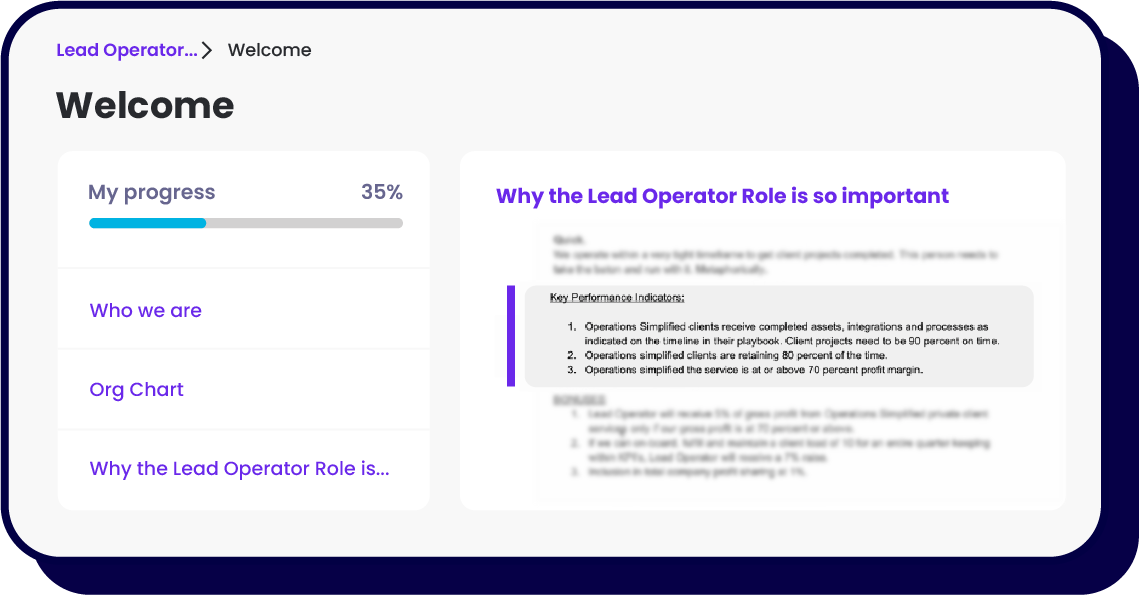
Articles
Build High Performance Teams With KPIs
December 20, 2021

Want to know one of the most undervalued tools to train and maintain high-performing teams? Key performance indicators (KPIs)!
That’s because business owners who use KPIs have more predictable outcomes. Because they help business owners make more informed decisions about the future.
Plus, KPIs lead to better relationships with employees. Because they help to accurately measure performance and directly pinpoint areas of improvement. Meaning, KPIs make feedback more objective.
Lots of our clients come to us without KPIs in their business. And because of that, they’re leaving a ton of upside on the table. So, I’m here to break down everything you need to know about KPIs so you can implement them in your business.
👉 Want me to help you identify the key KPIs you should be tracking in your business? I'm giving you access to my KPI video workshop for free. Use code TRAINUAL at checkout when you sign up here.
What are key performance indicators?
KPIs are numbers that measure the output, input, or performance in particular areas of your business. For example, in the sales process, that could be the number of cold calls made (an input), the number of new clients (an output), and the close rate (efficiency).
To get even more nitty gritty, the KPIs that measure inputs are usually called leading metrics. That’s because these metrics tend to predict how other metrics will perform based on the direction it’s headed.
The KPIs that measure output or performance are usually called output metrics. Meaning, they measure the company’s results.
Lastly, the KPIs that measure your business’s productivity are your efficiency metrics. These help to give you more context around your input and output indicators. Because sometimes, looking at them in a vacuum isn’t helpful.
Why KPIs are important
KPIs help business owners make more informed, objective decisions than those who don’t use them. That’s because they provide a more accurate picture of what the root causes are of good or bad performance.
For example, let’s say that on average, 100 cold calls per day will likely yield 20 new clients in our sales process. That means a close rate of 20%. Here’s how we can use these numbers to assess performance:
If our sales suddenly decrease and we see that the number of cold calls is less than 100 per day, then we’ll likely need to find out why our sales team isn’t calling.
Or, if the close rate begins to drop below 20%, we’ll know to look at the quality of leads, sales call performance, or the time of day the sales reps are making calls.
If we didn’t have KPIs in this case, and our sales went down, we would just be making best guesses. And as we know, trial and error can be expensive…
A personal example
To drive the point even further, here’s an example from my personal life:
Last month I took a month-long road trip with my family around the north-east coast. It was our first time traveling with our son who was 9 months old at the time.
All the essentials and affirmations were in tow.
We (okay - I) painstakingly planned, packed, and mapped out everything. Including where we would spend time in each location, for how long, and what we would need. Plus, I figured out how the heck we were going to pack the car to fit all the baby things inside.
We traveled from Nashville, Tennessee up to the New Jersey shore, up to New Hampshire, into New York and back again all in 30 days. The trip was exactly 845 miles and roughly 12.5 hours total driving time.
Throughout the entire trip, everything was marked: mile markers, interstate signs, directions, and speed limit signs.
We knew how far until our next exits, to slow down before taking a large turn or when we were merging - all by reading the signs on the road.
So, while on this adventure with our family, we didn’t get led astray or hit an upcoming curve at 5% grade too quickly. Thanks to those signs along the way acting as the KPIs for our trip.
Just like using the signs on a road trip, KPIs allow you to feel that level of safety, certainty and predictability that comes with a highly measurable business. That’s because using KPIs consistently can feel like you have the exact map for your goals.
They let you give your team the route, the markers, and the speed to leverage to get them to your businesses’ version of “Nashville.” That way, you and your team have what you need to feel safe, comfortable, and unstoppable on the journey.
Identify which key performance indicators you need to track
This is the main question I get asked every day in my strategy sessions with clients. First, let’s discuss how to think about KPIs. To use another analogy: ever seen a set of Russian nesting dolls?
They look like this:
These dolls have smaller nested versions just under the larger one. And one after another, they get smaller and smaller.
Well, whenever I think of KPIs (as strange as it sounds), I think of these dolls. Because we can look at data the same way.
There are big indicators, like profit, sales, and leads. Then, there are smaller, nested, metrics that directly affect those larger indicators. AKA posting frequency, phone consultations booked, and project delivery timeline.
So, when we begin to set up KPIs, we want to take our big business metrics and ask ourselves: “what is something small that I can track that is in direct correlation with that big number?”
As you ask that question, make a list and write down everything that comes to mind. Then, map out how each of those numbers affect each other. I suggest coming up with at least 4-5 smaller metrics from this exercise.
For example, if revenue is the big metric you’re tracking (which is likely true), the smaller data points could be mapped out like this: Revenue > Sales > Phone Consultations booked > follow up emails > webinar views
Then, with your list of metrics, determine which ones will be the most important or impactful to focus on to reach your goals. For instance, if you are looking for a high-revenue year, you’ll likely want to pick a metric that directly relates to revenue.
But regardless, I suggest defining your KPIs in 4 key areas:
- Marketing: how are we spreading the word and attracting new people into our ecosystem?
- Sales: how are we converting leads into paying customers?
- Delivery: how are we delivering high-quality services and experiences to our customers?
- Scale: how is our business growing month over month, year over year without sacrificing standards?
If you can get KPIs in those areas identified, you’re off to a great start.
How to roll KPIs out to your team
Getting your team’s buy-in on KPIs is a huge piece of the puzzle. Because you need to make sure that they own their metrics and have a stake in the game. That way, everyone is aligned with what they’re supposed to hit. Plus, the right people are held accountable to driving the results your company needs.
A great way to get buy-in from your team is to have them help you create the KPIs they will be responsible for. Because they are the ones who are more in the day-to-day operations of your business. Meaning, they’ll know exactly what smaller metrics affect the big ones.
🔥 Tip: Have a meeting with your team and ask them to prepare 2-3 metrics they believe are important to the business and that they have direct control over.
Once those metrics are listed out, it’s time to assign them out to their owners. I suggest every person should get least 3-5 KPIs assigned to them.
What metrics each team member should own
To start, each member should own at least one of the three types of metrics I explained earlier:
- A leading metric (ie. how many calls, how many fliers made).
- An output metric (ie. the end goal, sales, leads).
- An efficiency metric (ie. adding a cost per task or a limit to turn around time)
Out of the list of metrics you brainstormed with your team, you should find at least one of each of these categories that each role owns.
For example, if you’re hiring a customer service representative, their metrics might look like this:
- Phone answered every time it rings during normal business hours (leading)
- All support tickets closed completely within one business day (efficiency)
- An NPS score of 8 or more (output)
That way, they’re held accountable to owning metrics that have to do with all stages of the processes they own.
Where to roll out KPIs
So, once these metrics are defined, where do you roll them out to make sure everyone is held accountable to them?
I suggest that you introduce them in two key places: during your onboarding process and in your company scorecard.
The onboarding process
The best time for your team to get introduced to what KPIs they own is during their very first day. That way, they’ll be crystal clear on what metrics they should be focusing on improving from the get-go.
One of the easiest ways to add a person’s KPIs in the onboarding process is to add them to each role’s training content in Trainual. And since it’s best to introduce them as early as possible in their onboarding, I suggest adding it in a document that they’ll review early. Such as their role overview or a breakdown of their team

The scorecard
Another way to roll-out KPIs would be by using a scorecard. AKA a dashboard that tracks all the important metrics that your team owns.
The scorecard is not only meant to show your team which metrics are actually important - it’s also an easy way to easily track how your KPIs are doing. Because it puts all of your important data front and center.
To create the scorecard, you can use a simple Excel or Google spreadsheet that your team updates with the most recent information.
We suggest updating most of your metrics on a weekly basis. That way, if your KPIs start to go south, you’ll have 52 opportunities to pivot during any given year.
But, for your output metrics (sales, for example), you can opt to track this either bi-weekly or monthly. That’s because these can be affected by a ton of external factors on any given week (like the holiday season). So, looking at them week-by-week may not be useful.
Either way, having your team regularly tracking their metrics builds a culture of ownership. That’s because your team is consistently reporting on the results they’re driving for your company. And it keeps those metrics top of mind for them as they do their jobs.
Once you have your scorecard set-up, it’s crucial to have it in a place that’s centralized and simple to find. That way, everyone can easily check in on the metrics and see how the company is doing.
🔥 Tip: With Quick Embeds, you can embed your scorecard on Google Sheets directly into Trainual. That way, it’s in a centralized location. And it automatically updates with the latest data. Try for free.
How to make updating your KPIs easier
Updating your scorecard every month or week may sound like a lot of work. And admittedly, it can be. But if you set up a system to streamline how to update your KPIs, you can save yourself a ton of time in the future.
There are two ways to go about collecting data:
- Automated. Use an automation software (like Zapier) that links with the apps that track your data to automatically update your scorecard.
- Manually. One of your team members gathers and exports the data from a platform. Then, they directly enter the data into your scorecard.
For the easy numbers that are quick to find (like lead amount, blog views, or sales), you can probably get away with entering them manually. And even if you don’t want your team to spend time inputting them, you can use a Virtual Assistant to enter them in for you.
But for metrics that take a long time to pull, those may need to be automated. If that’s the case, you’ll need to make sure that the apps you use to track that data can integrate with the automation software you’ll use. So, make sure you double-check that before you commit to using automation software.
I suggest doing an audit of all of your data collection tools, and see if they have any automation capabilities (either internally or with a separate automation tool). If your tool can do that, great! They’ll likely have some help docs that will help you set those up.
But if not, and it's a tedious process to continuously pull the numbers, it may be worth it to find a new tool that does. Because when you scale, it’s only going to get harder to manually manage those numbers.
Regardless, implementing a system to update your KPIs early-on will help to set you up for success in the future. Plus, you sleep better at night knowing that your business has a clear path forward to hitting its goals.
Want me to show you how to use KPIs in your business?
If you're still looking for a crystal clear list of the best key performance indicators to track, I got you covered. This year, I've decided to pull back the curtain on what I share with only my private clients around tracking, metrics and measuring success. And these tools are universally implementable within every business I've ever worked with.
It'll help you stay objective about progress and not wonder at the end of the year or the quarter where things might have fallen off. And with these tools, you'll be confident about your goals and what it takes to get there.
So, join me for a free online workshop where I'll show you how to set-up KPIs in your business. All you have to do is enter the code TRAINUAL at checkout to get the workshop for free. Sign up here!
Similar Blog Posts






.avif)




